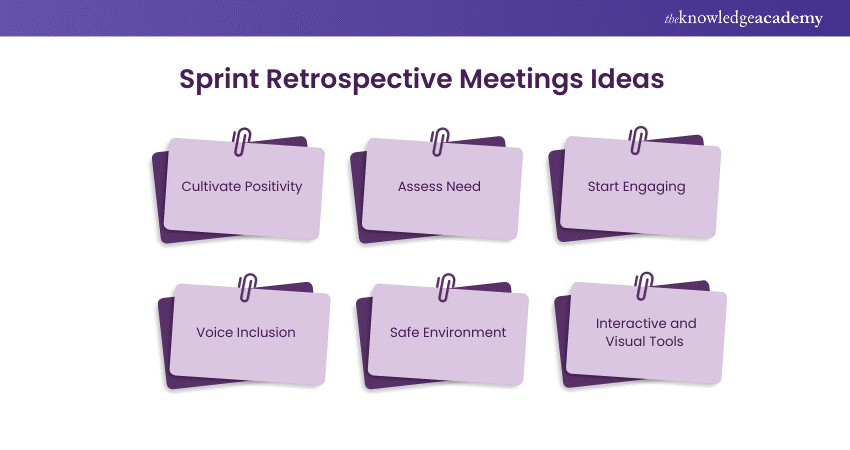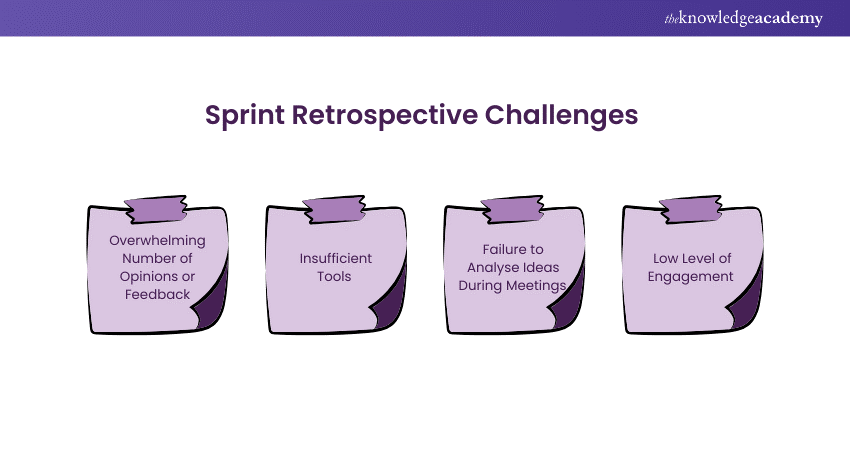We may not have the course you’re looking for. If you enquire or give us a call on 01344203999 and speak to our training experts, we may still be able to help with your training requirements.
Training Outcomes Within Your Budget!
We ensure quality, budget-alignment, and timely delivery by our expert instructors.

Imagine that you're part of a sports team. After every game, your coach brings you together to discuss certain things. The discussion spans over the positive things that happened, the areas of improvement, and what the team could do to play better together. In Agile project management, a Sprint Retrospective works exactly like that meeting for a team.
It is a dedicated time at the end of a sprint, where the team reflects on the work done, what went fine, and what issues were hit, and then plans to improve the performance in upcoming sprints. Explore how teams reflect on their work, identify improvements, and enhance collaboration.
Table of Contents
1) What is Sprint Retrospective?
2) Objectives of Sprint Retrospective
3) Who runs a Sprint Retrospective meeting?
4) How to run a Sprint Retrospective?
5) Sprint Retrospective meetings ideas
6) Sprint Retrospective Challenges
7) Conclusion
What Is Sprint Retrospective?
Sprint Retrospective is one of the critical functions of the Agile framework in Project Management, and more so in Scrum methodologies. This is a meeting at the end of every sprint cycle where the team discusses three key issues: what went well, what could be done better, and how the team plans to enact change toward making the next sprint more effective. The objective of this Scrum meeting is to continue a culture of improvement, collaboration, and team empowerment.
Objectives of Sprint Retrospective
The purposes of a Sprint Retrospective are to:
1) Reflect on the achievements of the most recent sprint and how much improvement was there in each area.
2) Identify any barriers or challenges that could be addressed.
3) Come up with a plan for how the improvements are going to be implemented in the next sprint.
4) Enhance team dynamics and efficiency.
5) Encourage a transparent, open communication culture in the team.
Who runs a Sprint Retrospective Meeting?
Normally, the Sprint Retrospective is facilitated by the Scrum Master, ensuring that he or she is an effective and focused session. The meeting is supposed to be attended by the Product Owner, developers, and other stakeholders. The Scrum Master facilitates communication with care so that all have their say and the meeting does not overrun the Scrum timeboxed time.
Enhance your career prospects and earning potential with our Scrum Certifications!
How to Run a Sprint Retrospective?
1) Goal Setting
Clearly define the objective of the retrospective. The team should clearly define what they want to have achieved by the end of the session: This may be solving a particular problem, improving relationships among the team, or enhancing the processes involved.
2) Data Collection
Obtain data and feedback on the sprint; this is inclusive of metrics, completed tasks, achieved milestones, and any impediments encountered. All these will help to build a discussion based on perception and not what is factual.
3) Developing Insights
Analyse the data that you have collected so as to draw insights into team performance. Discuss what has worked well and what hasn't. The discussion should be open, candid, and positive to learn from the best and worst situations.
4) Action Planning
From the insights developed, the team should formulate actionable steps that can be realistically implemented in the next sprint. These actions should be specific, measurable, and assigned to individuals to ensure accountability.
5) Closing the Retrospective
Conclude the meeting by summarising the discussions, the actionable items agreed upon, and the steps each team member will take before the next retrospective. This helps to ensure that everyone leaves the meeting with a clear understanding of their responsibilities.
Improve your organisational efficiency through our Scrum For Teams Course!
Sprint Retrospective Meetings Ideas
Here are some of the ideas you might want to incorporate in the meeting from now on:

1) Cultivate Positivity
The Initiation of the Sprint Retrospective with a bright tone is one of the important factors. The objects of the exercises are to provide an effective session in which members are recognised as individuals valued and inspired. An excellent way of creating a positive environment is through the commencement with appreciation, where every member acknowledges specific contributions, they made during the sprint. This builds the group and type of culture, which agrees that it is important to appreciate effort.
2) Assess Need
Before delving into the discussions of what went wrong or right, it’s important to assess the needs of the team. Understanding what the team members feel are the priorities for discussion can guide the retrospective agenda. This can be done through pre-meeting surveys or a quick round of gathering inputs at the start of the session. By aligning the meeting’s focus with the team's immediate needs, the retrospective becomes more relevant and focused.
3) Start Engaging
Engagement during retrospectives is vital. The facilitator should employ techniques to ensure that everyone participates actively. Using ice-breaker activities or having team members lead parts of the discussion are great ways to increase engagement. Another method is the “Lean Coffee” format, where topics are democratically chosen and discussed in a time-boxed format, ensuring that the meeting progresses energetically and that discussions remain democratic and engaging.
4) Voice Inclusion
Every team member should have a voice in the retrospective. It’s essential that the quieter members are encouraged to share their insights and that more dominant personalities do not overpower the session. Techniques such as the “silent writing” exercise, where everyone writes down their thoughts before sharing them aloud, can help in balancing participation. This ensures that all perspectives are heard and considered.
5) Safe Environment
The fundamental agreement is that we undertake safe procedures, which is a highly important factor towards making a successful retrospective. A healthy team culture is greatly defined by staff being free to raise any concerns or ideas without the fear of being blamed or warned. Establishing ground rules at the meeting's beginning by setting up “these words will never leave the group, and every contribution is welcome” can lift the level of safety and trust among the group members.
Enhance your managerial skills with our Managing Agile Projects With Scrum Course - Sign up today!
6) Interactive and Visual Tools
Using interactive and visual tools can significantly enhance the effectiveness of retrospectives. Tools like digital whiteboards, real-time polling, and mind-mapping software can make the meeting more dynamic and engaging.
Visual aids help in better understanding complex issues and retain the attention of the team throughout the session. Additionally, these tools can be used to keep a record of discussions and actions, making it easier to follow up in future sprints.
Sprint Retrospective Challenges
Here are a few challenges that one may face in their Sprint Retrospective journey:

1) Overwhelming Number of Opinions or Feedback
Managing a large volume of opinions and feedback can be challenging. Prioritise issues based on their importance and its potential impact and address them systematically.
2) Insufficient Tools
A lack of adequate tools can hinder the effectiveness of the retrospective. Invest in proper tools that facilitate easy communication and data analysis.
3) Failure to Analyse Ideas During Meetings
Sometimes, due to time constraints or poor meeting management, ideas and feedback are not adequately analysed during the meeting. Plan the retrospective with clear time allocations for each section to ensure thorough discussion.
4) Low Level of Engagement
Combat low engagement by making meetings more interactive and ensuring that all team members understand the value of their contributions.
Conclusion
“What is Sprint Retrospective” is thus no more a difficult question to answer. It is a vital practice within Agile and Scrum methodologies, fostering continuous improvement, collaboration, and team empowerment. By following structured processes, fostering positivity, and employing interactive techniques, teams can effectively address challenges, enhance performance, and cultivate a culture of transparency and trust.
Want to improve your Scrum skills? Register to our Scrum Developer Training today!
Frequently Asked Questions

Velocity in Scrum is calculated by summing up the effort estimates of all completed user stories or backlog items during a sprint, providing a measure of the team's productivity.

The 3Cs of Scrum are Card (the work item), Conversation (discussion about the work), and Confirmation (agreement on the completion criteria). They ensure clarity and alignment in the team's understanding of the work.

The Knowledge Academy takes global learning to new heights, offering over 30,000 online courses across 490+ locations in 220 countries. This expansive reach ensures accessibility and convenience for learners worldwide.
Alongside our diverse Online Course Catalogue, encompassing 17 major categories, we go the extra mile by providing a plethora of free educational Online Resources like News updates, Blogs, videos, webinars, and interview questions. Tailoring learning experiences further, professionals can maximise value with customisable Course Bundles of TKA.

The Knowledge Academy’s Knowledge Pass, a prepaid voucher, adds another layer of flexibility, allowing course bookings over a 12-month period. Join us on a journey where education knows no bounds.

The Knowledge Academy offers various Scrum Certification Training, including Scrum Master Certification Course, Scrum Product Owner Training and Scrum Developer Training. These courses cater to different skill levels, providing comprehensive insights into Agile Project Management With Scrum.
Our Project Management Blogs cover a range of topics related to Scrum, offering valuable resources, best practices, and industry insights. Whether you are a beginner or looking to advance your Project Management skills, The Knowledge Academy's diverse courses and informative blogs have you covered.
Upcoming Project Management Resources Batches & Dates
Date
 Scrum Master Certification
Scrum Master Certification
Thu 2nd Jan 2025
Thu 9th Jan 2025
Thu 16th Jan 2025
Thu 23rd Jan 2025
Thu 30th Jan 2025
Thu 6th Feb 2025
Thu 13th Feb 2025
Thu 20th Feb 2025
Thu 27th Feb 2025
Thu 6th Mar 2025
Thu 13th Mar 2025
Thu 20th Mar 2025
Thu 27th Mar 2025
Thu 3rd Apr 2025
Thu 1st May 2025
Thu 22nd May 2025
Thu 5th Jun 2025
Thu 19th Jun 2025
Thu 3rd Jul 2025
Thu 17th Jul 2025
Thu 31st Jul 2025
Thu 14th Aug 2025
Thu 11th Sep 2025
Thu 25th Sep 2025
Thu 2nd Oct 2025
Thu 9th Oct 2025
Thu 16th Oct 2025
Thu 23rd Oct 2025
Thu 30th Oct 2025
Thu 6th Nov 2025
Thu 13th Nov 2025
Thu 20th Nov 2025
Thu 27th Nov 2025
Thu 4th Dec 2025
Thu 11th Dec 2025
Thu 18th Dec 2025







 Top Rated Course
Top Rated Course



 If you wish to make any changes to your course, please
If you wish to make any changes to your course, please


